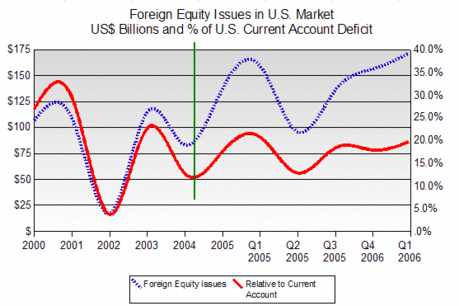Foreign Stock Issues Continue Despite Sarbanes-Oxley: Q1 2006
Despite unpopular conditions imposed by the Sarbanes-Oxley Act, foreign issuers have continued to sell equities into the US market during Q1 2006.
The volume of foreign stocks issued to the US market increased significantly from highs set in 2000, as the graph shows (blue line - left axis).
 Foreign Equity Issues in US Market vs. Current Account Deficit
|
||
The graph indicates that the volume of foreign stock issues averaged about 15% to 20% of the U.S. current account deficit, with dampening oscillations (red line - right axis ).
Foreigners Neutralize Effects of Stock Buybacks
About half of the time since 2000, non-US investors bought more stocks on the US market that foreign issuers sold. See the next graph (red bars = foreign investors, blue bars = foreign issuers).
Throughout the period, US households were net sellers of equities, mainly in connection with stock option programs.
The effect of foreigners on the US equity market has been to dampen the effects of price manipulation driven by buyback-option programs.
|
Foreign Investors in Equities vs. Foreign Stock Issues in US Market
|
||
Domestic Corporations Abandon Restraint After 2005
The volume of stocks issued by foreign corporations into the US market, as compared to stock taken off the market by buybacks of domestic corporations, was until 2005 a useful indicator of the capacity of domestic corporations to use buybacks to set stock prices and give value to stock options.
However, as the next graph suggests, after 2005 the volume of stock buybacks (blue bars -left axis) surpassed prior levels by a substantial margin, dwarfing records set at the peak of the Great Bubble (2000).
|
Foreign Stock Issues vs. Domestic Nonfinancial Buybacks
|
||
The green line on the graph (right axis) shows that foreign equity issuance was large enough, relative to buybacks, to counteract the effect of repurchases as recently as 2002.
Although foreign issuers continued to sell equities into the US market at comparable rate to the recent past, domestic corporations by 2005 had thrown off restraints, diverting ever-greater volumes of corporate funds to insiders through buyback-option schemes (blue bars - left axis).
By Q1 2006, the buyback phenomenon that had supported stock prices for well over a decade, to the detriment of long-term investors, reached a point where corporations were willing to go into the bond market and spend depreciation reserves to fund stock repurchases.
If foreign issuers flee the US equity market because of the Sarbanes-Oxley Act, this will remove one last brake on domestic corporate efforts to manipulate stock prices upwards through buybacks, thereby making it even easier to ‘prove’ to naïve investors (who dominate the market today) of executive ‘performance’ that justifies multi-million dollar remuneration packages.



























